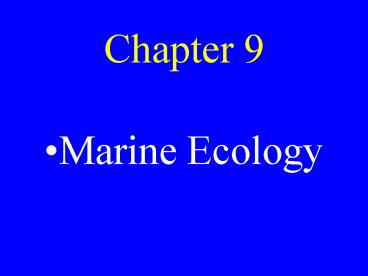Marine Ecology - PowerPoint PPT Presentation
1 / 77
Title:
Marine Ecology
Description:
Chapter 9 Marine Ecology Chapter 9 Marine Ecology Bathypelagic Deep water where it is completely dark Abyssopelagic Water near the sea floor Hadopelagic Water in deep ... – PowerPoint PPT presentation
Number of Views:136
Avg rating:3.0/5.0
Title: Marine Ecology
1
Chapter 9
- Marine Ecology
2
Habitat
- The place where an organism resides
3
Ecology
- The study of the interaction of organisms with
their environment
4
Biotic
- Living
5
Abiotic
- Non-living
6
Resources
- Anything an organism needs to survive
- Trouble when short
7
Nutrients
- Required substances other than O2, CO2, H2O,
sunlight
8
Growth Curve
- A graph representing growth over time
9
(No Transcript)
10
Self Regulation
- Growth rate depends on its own population due to
limited resources
11
(No Transcript)
12
Natural Selection
- Survival of the fittest
13
Evolution
- Genetic changes over many generations due to
natural selection
14
Competition
- Fighting over resources
15
Competitive Exclusion
- When one species becomes extinct due to losing
out in the struggle for resources
16
Resource Partitioning
- Sharing resources
- Each species find a way to get its share of
resources
17
Ecological Niche
- How each species fits in
- Unique methods that species adapt to
18
Predation
- One organism eating another
19
Predator
- The organism doing the eating
20
Prey
- The organism getting eaten
21
Carnivore
- Meat eater
22
Herbivore
- Plant or algae eater
23
Coevolution
- When two species are involved in competition or
predation, both improve
24
Symbiosis
- Living together in some association
25
Symbiont
- Smaller partner in a symbiotic relationship
26
Host
- Larger partner in a symbiotic relationship
27
Types of Symbiosis
- Mutualism
- Commensalism
- Parasitism
28
Mutualism
- A symbiotic relationship in which both partners
benefit
29
Commensalism
- A symbiotic relationship in which one partner
benefits while the other is unaffected
30
Parasitism
- A symbiotic relationship in which one partner
benefits at the others expense
31
Autotrophs
- Produce their own food
- Carbon fixers
- Producers
32
Heterotrophs
- Must consume food
- Consumers
33
Food Chain
- Chain of organisms in which successively larger
organisms eat smaller ones
34
(No Transcript)
35
Trophic Levels
- Primary producers
- Primary consumers, 1st
- Secondary consumers 2nd
- etc
36
(No Transcript)
37
Food Web
- Because most species eat many different species,
each species can be linked to many
38
(No Transcript)
39
Determining Trophic Levels
- Each trophic level is classified as one level
above the highest level its organisms consume
40
Top Predator
- The top animal in any food chain
41
Biomass
- The total mass of an entire species or designated
group
42
Trophic Pyramid
- Pyramid of levels designed to show relative
biomass of each level
43
(No Transcript)
44
Decomposers
- Organisms that help break down other organisms
45
Detritus
- The combination of sediment, dead organic matter,
waste products, and decomposers on the bottom
46
Productivity
- A measure of the carbon fixation within an unit
volume
47
(No Transcript)
48
Carbon Fixation
- Converting atmospheric carbon in the form of
carbon dioxide to a usable form (organic matter)
49
Nitrogen Fixation
- Converting atmospheric nitrogen in the form of
nitrogen gas to a usable form (organic matter)
50
Standing Stock
- The biomass of organisms that exist at any given
time
51
Chlorophyll
- The main pigment that absorbs energy in the form
of light that is used to drive photosynthesis
52
Nutrient Cycles
- Carbon Cycle
53
(No Transcript)
54
Nutrient Cycles
- Nitrogen Cycle
55
(No Transcript)
56
Biological Zonation
57
Pelagic
- In the water column
58
Planktonic
- Organisms that cannot swim against the currents
- Floating or drifting organisms
59
Phytoplankton
- Photosynthetic plankton
60
Zooplankton
- Heterotrophic plankton
61
Nektonic
- Organisms that can swim against the currents
- Swimming organisms
62
Benthic
- Bottom dwelling
63
(No Transcript)
64
Epipelagic
- Surface water where light can penetrate
- Photic zone
65
Mesopelagic
- Middle water just below where light can penetrate
where shadows exist - Twilight zone
66
Bathypelagic
- Deep water where it is completely dark
67
Abyssopelagic
- Water near the sea floor
68
Hadopelagic
- Water in deep trenches
69
Splash Zone
- Area of the shoreline just above the highest
tides that get wet with spray from the waves
70
Intertidal Zone
- Area of shoreline between the lowest and the
highest tides
71
Subtidal Zone
- Benthic area from the lowest tides to the edge of
the continental shelf (shelf break)
72
Bathyl Zone
- Benthic region along the continental slope
73
Hadal Zone
- Benthic areas in trenches
74
Abyssal Zone
- Benthic area of the sea floor
75
(No Transcript)
76
Coastal Zone
- Area of the oceans near shore or along the
coastline - Neritic Zone
77
Oceanic Zone
- Area of the oceans away from shore































